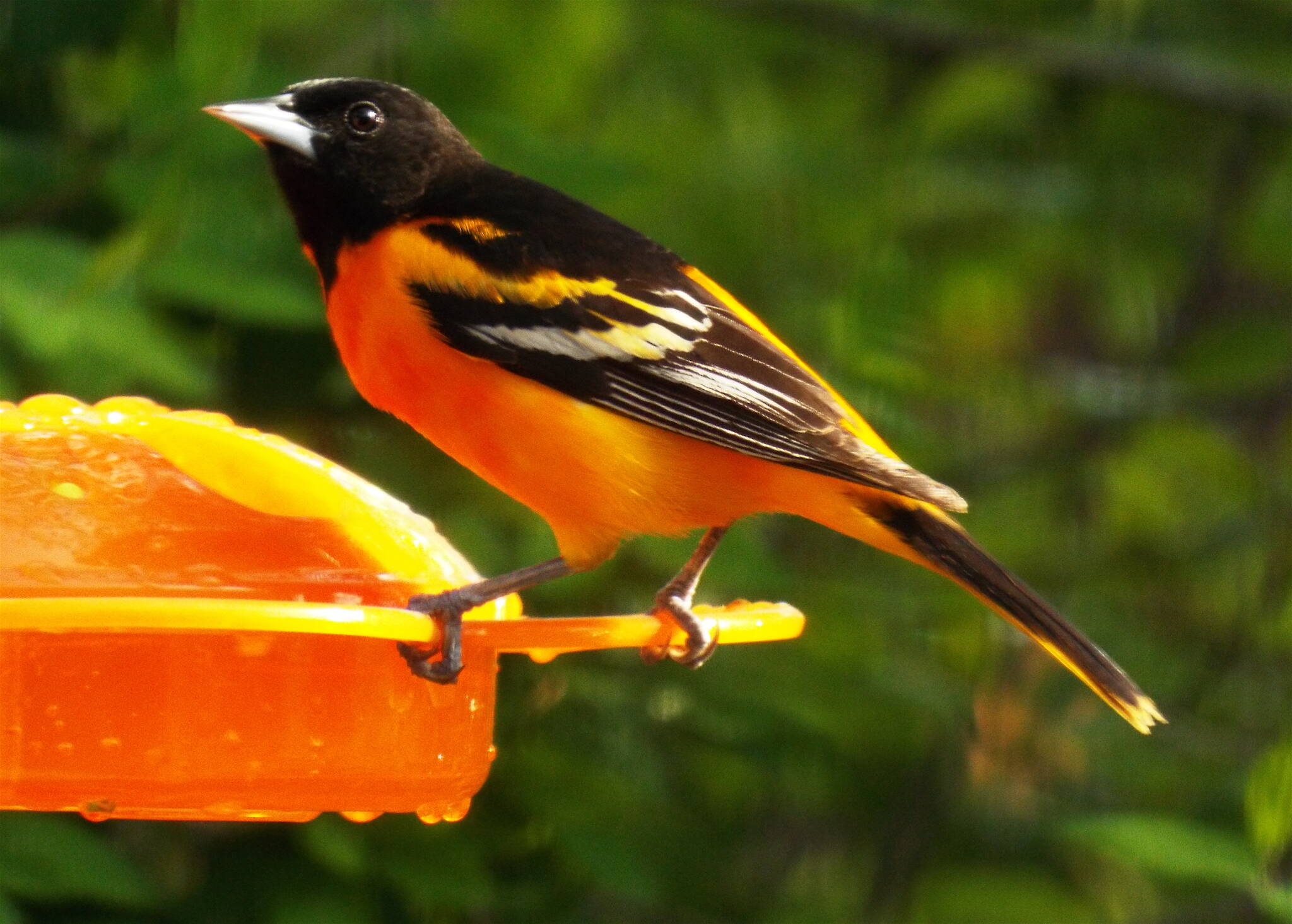Colors are produced by cell structure, which can scatter light rays, making iridescence, and by pigments, which absorb or reflect particular wavelength of light. Pigments that absorb all the rays of the spectrum look black; those that reflect all the wavelengths look white.
Some pigments, such as melanin, are synthesized by the body from amino acids and other break-down products of metabolism. There are two forms of melanin; one makes black and gray hues; the other makes rusty, brownish, gold, and yellow hues. These pigments tend to be stable — almost always present in sufficient quantity. Green feathers are rare, mostly created by yellow pigment over blue structural colors; but not in African turacos, which actually have a unique green pigment. Why?
In contrast, reds and yellows (and oranges resulting from mixtures of these) are usually produced by various types of carotenoid pigments, which cannot be synthesized by most birds. Carotenoids are obtained directly from foods and the entire carotenoid molecules are moved from the digestive tract to where they are deposited and used. However, certain species can alter the ingested yellow pigment to a brighter yellow (e.g., goldfinches) or produce red pigments by chemically changing yellow pigments acquired in the diet (e.g., cardinals). Parrots are exceptional—they are able to synthesize their own reds and yellows with different (not carotenoid) chemistry. I have to wonder: How did that happen!?
Observations of captive birds have shown the importance of carotenoids in the diet. For instance, male house finches on a diet of seeds (which are low in carotenoid content) don’t develop the characteristic red on head and chest—those feathers become pale yellow. But if fed supplemental carotenoids, the pale males grow nice red feathers the next time they molt. Similar changes have been noted in a number of other species in captivity, including flamingos, spoonbills, scarlet ibises, tanagers, and woodpeckers. In some cases, the supply of carotenoids also determines the color of the bill (e.g., zebra finches) or the color of facial skin (e.g., snowy egrets).
A major dietary source of carotenoids for many terrestrial birds comes indirectly from the leaves of plants: Birds that eat foliage-eating insects get yellow carotenoids (such as lutein) from their prey. For instance, European great tits have yellow breast feathers that are colored by carotenoids in the herbivorous caterpillars that they often eat. It turned out that tree leaves in urban environments (in Sweden) have less lutein than those in rural areas, so urban great tits are not as yellow as rural ones.
Egyptian vultures have yellow facial skin colored by carotenoids. The vultures forage on carrion, including dead sheep, eating not only the meat but also the feces in the guts. Sheep in green pastures have more carotenoids in their food and feces than sheep in dry, brown pastures, so vultures in the green pastures have yellower faces than the others.
Flamingos, spoonbills, and some other wading birds obtain red carotenoids by eating small aquatic crustaceans that contain these pigments, derived from planktonic algae. In addition, they can chemically convert yellow carotenoids from phytoplankton to red to achieve their colorful feathers.
Birders in eastern North America were astonished, decades ago, to observe that cedar waxwings were looking odd.
Instead of the usual yellow band at the end of the tail, some birds had an orange band there. How to account for this? Biologists found that an introduced, invasive honeysuckle was being planted (for erosion control and as wildlife food) in many places. This honeysuckle makes orange fruits that the waxwings promptly added to their normal diet, and the novel carotenoids in those fruits found their way to the tail bands. Now, orange-banded waxwings are quite common in the eastern part of their range.
Just to add to the complexity, birds’ eyes offer still more variation. Black and brown eyes are colored by melanin; yellow eyes of diving ducks and some herons come from carotenoids, red eyes may be colored by hemoglobin. But in most birds, there is a special pigment that is manufactured within the birds’ bodies, making yellow, red, or white. That, of course, raises the question of why those special pigments only function for eye color and not for feathers or legs or bills.
Avian colors are certainly important in many social interactions, such as mate choice. When color depends on diet, fine coloration is likely to be a signal of skillful foraging, and therefore a clue useful in choosing a mate. Similarly, good color is often a sign of health, another clue useful in mate choice. These considerations are a fruitful field for continuing research.
• Mary F. Willson is a retired professor of ecology. “On the Trails” appears every Wednesday in the Juneau Empire.

